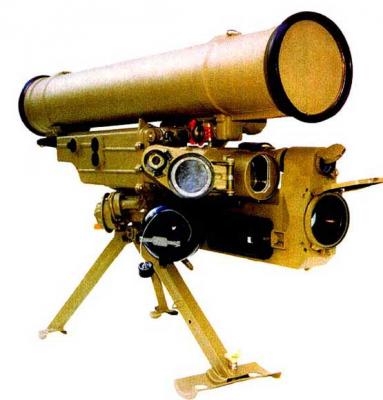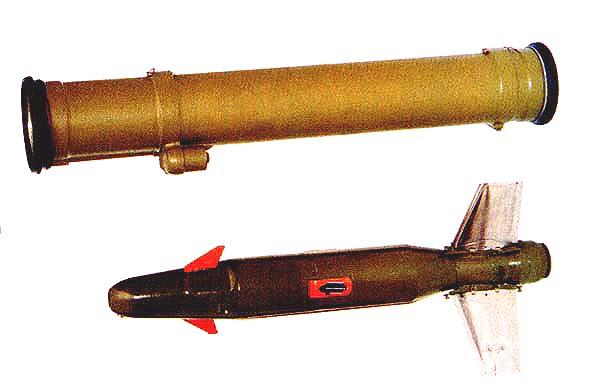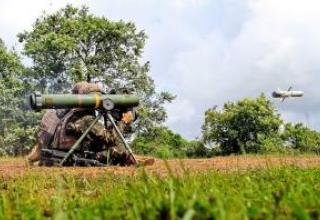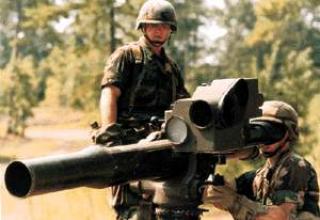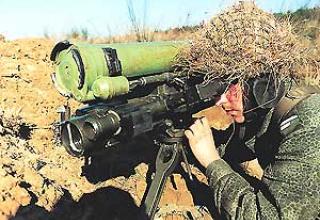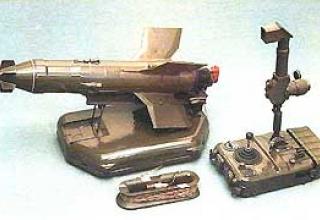The 9K115-2 "Metis-M" portable antitank missile system is designed to destroy modern and advanced armored vehicles equipped with dynamic protection, fortifications, enemy manpower, at any time of day, in difficult weather conditions.
It is based on the Metis PTRK. The concept of modernization consisted in maximal continuity in terms of ground facilities and ensuring the possibility of using in the complex as an ordinary missile "Metis" 9M115, and a new modernized - 9M131. Taking into account the perspectives of the tank protection growth, the designers resolutely increased the combat unit dimensions, moving from the 93 mm calibre to the 130 mm calibre. Substantial improvement of tactical and technical characteristics was achieved due to the growth of weight and dimensions of the PTUR.
The Metis-M complex was developed by the Instrumentation Design Bureau (Tula) and adopted for service in 1992.
It is intended to replace the previously created second generation complexes "Metis", "Fagot", "Contest".
In the west the complex has received designation AT-13 "Saxhorn".
It was used during the military conflict in Syria in 2012.
A modernized version of the complex was developed for the Russian army, which received the designation "Metis-M1". The complex (see the brochure) was upgraded in order to increase the range of fire, increase the power of the combat unit and reduce the weight of the launcher, while maintaining all the positive properties of the Metis-M complex.
The Metis-M1 anti-tank missile system was adopted by the Order of the Government of the Russian Federation dated 9 November 2015, as well as by the Order of the Minister of Defence of the Russian Federation dated 2 March 2016.
Composition:
The complex consists of:
- 9P151 launcher with sight - guidance device, guidance drives and rocket launcher (see photo);
- thermal imaging sight 1ПН86БВИ "Mulat-115" ;
- 9M131 missiles, placed in transport and launch containers.
- 9B12M and 9B81M test and verification equipment;
The wings of the 9M131 rocket are made of thin sheets of steel and are opened after launch under the action of their own elastic forces. As in the rocket 9M115 "Metis", the adopted technical solutions, in particular the placement of the track on the tip of one of the three wing consoles, allowed to abandon the use of gyro devices, on-board batteries and electronic units. During the missile's flight the tracker moves in a spiral, the ground equipment receives information about the angular position of the track and corrects the commands issued by the wire line to the missile's controls.
The new powerful tandem cumulative combat unit of the PTUR complex is capable of engaging all modern and advanced enemy tanks, including those equipped with hinged and built-in dynamic protection, light armoured vehicles, fortifications. And the high level of pressure arising during penetration both in axial and radial directions, leads to crushing of concrete in the area of passage of cumulative jet, breaking of back layer of an obstacle and, as a consequence, to high barrier action. In this way, it is possible to defeat the living force behind concrete monolithic objects or in precast concrete structures with walls up to 3 meters thick.
In order to expand the range of combat application of the Metis-M complex, the 9M131F guided missiles are equipped with a 4.95 kg thermobaric warhead with a blast effect at the level of a large-caliber artillery projectile, which is especially effective when firing at engineering and fortifications. Such BC explosion generates a shock wave longer in time and space than that of traditional explosives. Such a wave spreads in all directions, flows behind obstacles, into trenches, through embrasures, etc., affecting the live force, even protected by shelter. In the zone of detonation transformations of thermobaric mixture there is a complete combustion of oxygen and develops a temperature above 800 ° C.
Located on a tripod, the launcher can be equipped with a thermal imaging sight 1PN86-VI "Mulat-115" weighing 5.5 kg, providing target detection at a range up to 3.2 km and their identification at a range of 1.6 km, which ensured the launch of missiles in night conditions to the maximum range. The dimensions of the thermal imaging camera are 387*203*90 mm. The field of view is 2.4°*4.6°. Battery life - 2 hours. Temperature range of application from -40 ° C to +50 ° C. In order to increase efficiency the sight uses a cylinder cooling system, which provides an output in 8-10s.
The rocket is launched by means of a launch engine, after which a marching RDTT is launched.
Calculation of the complex consists of two people, one of whom carries a 25.1 kg N1 pack with the launch unit and one container with the missile (see photo), and the other - a 28 kg pack N2 pack with two containers with the missile (instead of three for the Metis PTRK). When replacing the missile with a thermal imaging camera, the pack weight is reduced to 18.5 kg. Deployment of the complex to the combat position is carried out in 10-20s, the combat rate of fire reaches 3 shots per minute.
Along with its main purpose - to be used as a portable system, Metis-M can be used for armament of BMD and BMP.
It can be fired from prepared and unprepared positions from the lying position, from a standing trench and from the shoulder. It is also possible to fire from buildings (in the latter case, about 2 metres of free space behind the launcher is required).
The Metis-M1" is a part of the PTRK:
- starting device 9P151M;
- 9M131M, 9M131FM missiles (with thermobaric warhead);
- 9B569M control and test equipment;
- ZU-16-1 charger.
Characteristics:
| Range of fire, m | 80-1500 |
| The weight of the rocket, kg | 13.8 |
| Average rocket speed, m/s | 200 |
| Rocket Caliber, mm | 130 |
| Length of TPK, mm | 980 |
| PU weight, kg | 10 |
| Temperature range of combat application: | from -30° C +50° C |
| Time to move from camping to combat position, sec. | 10-20 |
| Armor-piermeable, mm | 900 |
| Battle count, man. | 2 |
Metis M1
| Range of fire day and night, m. | 80-2000 |
| Temperature range of application, °С | ±50 |
| Weight, kg: | |
| trigger device | 9,5 |
| container rockets | 13,8 |
| thermal imaging camera | 6,5 |
| pack 1 | 23,8 |
| pack 2 | 28,6 |
| camera shoot | 9,0 |
| Rocket caliber, mm | 130 |
| The length of the container with the rocket, mm | 980 |
Testing:
MTUR "Malyutka" was very successfully used during the Arab-Israeli War in 1973, it was with its help that almost the entire Israeli tank fleet was destroyed - about 800 vehicles. Only on October 6, 1973, for example, the 252nd Israeli Tank Division was defeated - more than a hundred vehicles were hit.
Sources:
- Конструкторское бюро приборостроения
- Р.Д.Ангельский "Отечественные противотанковые комплексы" -М: ООО "Издательство Астрель", 2002,-192с.
- Технологии в машиностроении - 2010 часть 6
- Гуров С.В. Ракетная техника в нынешнем военном конфликте в Сирии
